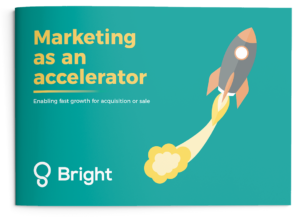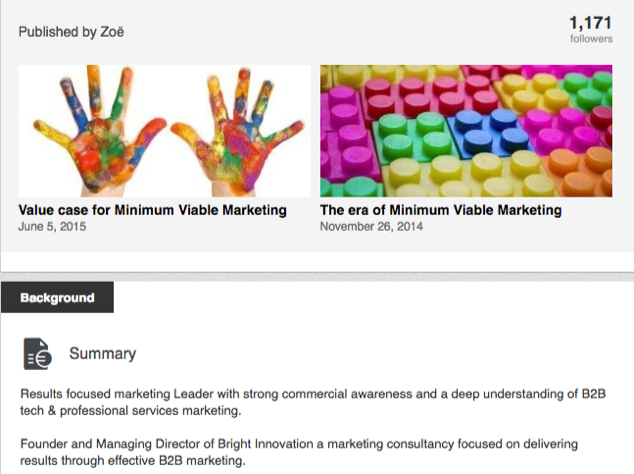Anyone interested in buying your business needs to know that it will continue to grow without you
As well as showing your business will continue to grow, buyers want to see that your sales and marketing teams are fully integrated, key stakeholders are invested, and you can successfully generate new interest as part of an overarching growth plan for your business.
Whether you have an internal team or work side-by-side with a marketing agency or consultancy, you need a clearly defined marketing leadership team driving ideas forward, with their full attention on growth activities.
The next four points look at how agile marketing can bolster business growth – making you more attractive to consumers and potential acquirers.
To hear exclusive insights from industry experts on how to leverage marketing to enable high growth, download our eBook: “Marketing as an Accelerator”
1. Plan for growth
Marketing plans are unique to every business.
The first step to developing an effective marketing plan is conducting a market analysis. This not only studies the dynamics of a specific market within a particular industry, it looks at evolving opportunities and threats that relate to your business’s own strengths and weaknesses. For a business looking to sell in the future, part of this is determining who potential acquirers might be.
To get the full benefits of a market analysis, we use this approach:
Performance diagnostic and market perception
First you need to understand your current customers, how they behave, how you are marketing to them and what seems to be working best. It’s also advisable to look at what your competitors doing, and if there are any trends likely to disrupt your efforts.
Objectives
Once you’ve completed your research, the next step is to look at what you need to achieve vs what you want. Optimism is never a bad thing, but we recommend leaning on the side of pragmatism when setting your objectives. Keep in mind the people you are competing with and establish a differentiation between your strategies and theirs. It’s also worth noting what you need to be doing to appeal to buyers in the long-term. You also need to consider how your marketing operation works and if it is agile and adaptable enough to support your business growth plans?
Plan of action
You’ve set your objectives, so now you just need to work out how to make those objectives a reality. If you have a marketing team or agency, use them to create a plan that is agile and focuses on: driving more of your successful activities and introduces new marketing activities in line with your objectives to support growth.
Kick-off:
There’s no time like the present! Brief your marketing and sales teams to implement the new strategy, and off you go – remember to set clear KPI and use data to understand performance by testing, learning and improving as necessary.
As well as optimising your marketing strategy, another benefit of a comprehensive plan is to give buyers confidence in your business. You’re not just thinking about growth, you’ve put in place a structure that allows it to happen – which is far more appealing. And regular reporting and analysis show that marketing efforts are an ingrained part of the business, not just a side show.
2. Stakeholder buy-in
For too long, marketing has been considered the ugly and costly step-child of the business, falling short of the bustling sales and innovative technology departments.
Yet marketing actions have been proven time and again to increase sales, promote and retain customer loyalty, and enable businesses to talk to people who have a genuine interest in their product or offering.
And still, it’s not uncommon for companies to leave marketing and sales to operate as entirely different entities. Which is peculiar, when both are set on the same goal: securing business and driving growth.
To have a successful growth plan, marketing needs to be feeding the top of the funnel for sales to convert further down the pipeline. Having a strong alignment between these two elements can bolster sales efforts by:
- Generating more leads
- Shortening sales cycles
- Retaining more customers
- Improving conversion rates
- Forecasting more accurately
- Implementing continual data driven improvement fuelling growth plans that work.
To achieve these results, both teams need to come together using an agile marketing hub approach to work towards aligned objectives, have complimentary systems and processes, and have strong communication and support from key stakeholders.
This buy-in from stakeholders is not only good for growth, it is also vital from a buyer’s perspective as harmony across the company is significantly more prosperous.
3. Build a pipeline to align your sales and marketing
Research today suggests that the majority of a buyer’s journey is complete before the sales team is engaged. This means there is more onus on marketing to influence a buyer’s decision earlier, especially as individuals are conducting more of their own research. But that doesn’t mean sales is out of the picture.
For customer acquisition and retention, sales and marketing need to become one force. The reason this works is because it responds directly to how the buyer journey has changed. Rather than regurgitating the same tactics, businesses are looking for fresh ideas to drive growth in their sales. Adding value comes from implementing real change, and sometimes this means introducing new processes that align teams that have historically not seen eye to eye.
Clear understanding of the buyer journey, lead management and defined qualification within your pipeline stages does just that.
By instilling the right culture, engaging your people work collaboratively and putting in place a strategy that influences people far beyond your personal network, you are automatically making your business more attractive to not only to prospects and customers, but also to potential buyers.
4. Make music, not noise
There’s a big difference between making noise and making music.
Whilst making noise is a traditional way of attracting attention, when there are over 2 million blog posts published every day, it won’t be enough. This is where marketing can help.
As mentioned above, understanding who your potential acquirers are can greatly impact how you approach your business objectives. Any market analysis should detail your investors’ profiles, identifying the content they read and where they read it, their interests and, in some cases, their dislikes.
To make music that gets the right attention, you want to become visible to possible investors in an authoritative sense. Wherever your investors are reading, that’s where you want your content featured. Whatever they are reading, that’s where you want your name mentioned. You want to get people in their close circles talking about your business, your offerings and the solutions you provide.
In the words of Nate Redmond, managing partner at Rustic Canyon Ventures, “the best companies are bought, not sold. We believe it is important to keep the focus on the long-term horizon until buyers come calling.” This means focusing a small percentage of your time on an exit strategy, but the majority building a real business that can scale.
Putting agile marketing to work to drive growth and acquisition
The above looks at just four ways marketing can help you plan for growth and make your business visible and attractive to potential acquirers. But marketing doesn’t stop there.
Using our unique capabilities and agile marketing methodology, Bright helps build integrated plans that drive success and growth for your business in both the short and long term. We collaborate with key stakeholders, building that bridge between sales and marketing to ensure you can roll out a growth plan that bolsters your business.
For more in depth analysis on how you can leverage marketing to enable fast growth, download our eBook: “Marketing as an Accelerator”












